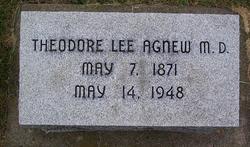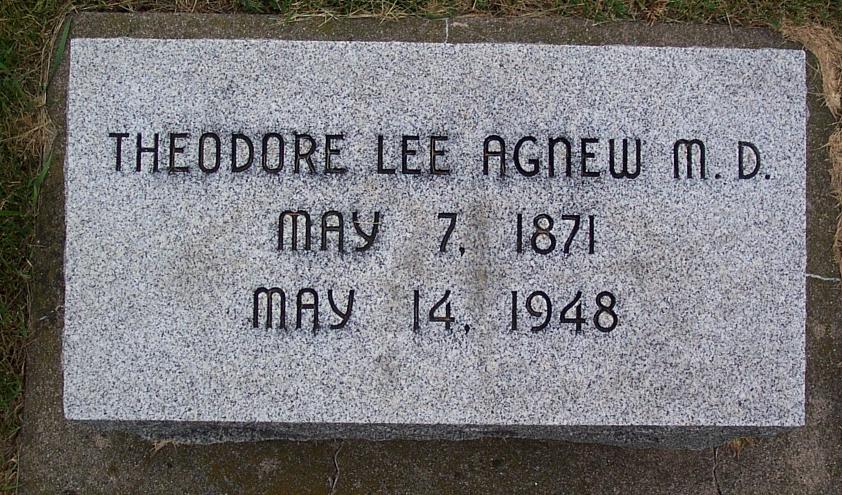Doctor Theodore Lee Agnew, 77, prominent Ogden physician and civic leader, died at 4:20 a.m. Friday at his home here. He had been in failing health for several years.
Dr. Agnew, who had practiced medicine here for almost 30 years, was on the official board of the Methodist church and was a member of the Masonic lodge and the Danville consistory. He served 15 years on the Ogden grade school board and was a trustee of Mt. Olive cemetery at Mayview.
He was born on May 7, 1871, at Makanda, son of Doctor Frank M. and Harriet Elizabeth Elmore Agnew. After attending Jackson county schools, he was graduated in 1892 from Southwestern Baptist University at Jackson, Tenn, and in 1895 from Marion-Sims medical college at St. Louis.
Doctor Agnew began medical practice at Makanda with his father, also practicing in Anna and Glasgow before coming to Ogden in 1916. He retired in 1943.
Doctor Agnew was married on Sept. 24, 1913, at Santa Fe, N.M., to Agnes Faris.
Surviving are his wife and six children. He also leaves two grandchildren and a sister, Louise Agnew, Makanda. One grandchild preceded him in death.
Unknown paper
Nov 6, 1945
by Joan Walker - News-Gazette Staff Writer
Stories with a frontier flavor unfold as four members of the Champaign County Medical society look back on 50 years participation in east central Illinois' drama of life and death.
The four doctors, recently honored by their colleagues for half a century of practice, are Doctors T. L. Agnew, Ogden; Annie Zorger, Champaign; J. S. Mason, Urbana; and F. S. Diller, Rantoul.
When they began traveling the county by horseback, in buggies, and on horse cars, they had only basic aids of medical science to aid them in their treatments. They watched the practice of medicine develop with the communities they served.
Doctor Agnew bought out the practice of Doctor G. A. Lutz in 1916 to become the standard physician in Ogden.
"Doctor Lutz took me around in his buggy and introduced me to his patients, and then I was on my own," Agnew recalls.
"Doctor J. F. Harris, an early physician in that community, was becoming too old to care for the medical needs of the people. I arrived just in time to get settled and know the people before the influenza epidemic which was so fatal.
"Every morning I left the house at 7 a.m. after instructing my wife to take all calls in my absence. As i went about calling on cases, i would phone back to learn if there were any new cases needing my help on the route, and then be off for more stops."
"The number of influenza patients was almost overpowering and impossible to handle," he continued. "I remember that I came home late one night after almost no sleep the night before expecting to get some rest for the long day ahead. There was a call wanting me to drive out to see a man who had been down with the 'flu' five days, so I started on the road again. I discovered that he was about in the crisis, so I gave him some medicine, put his wife to bed after three sleepless nights spent nursing him, and sat up the rest of the night with my patient. I'm proud to say he was better the next morning and soon recovered."
"During the bitter winter, my wife and I both worked day and night," he said. "I always gave her the route I would follow, and if I was out of the office when a patient came in, she would telephone me, give me the symptoms, and I would prescribe treatment. There was so much to be done that it was impossible to care for everyone properly."
After setting up practice in Ogden, Doctor Agnew built a six-room office in which he treated patients and kept complete medical supplies and equipment.
"All doctors at that time prepared their own medicines," he explained. "We ordered quinine in 30-ounce cans, and our powders came from Chicago or St. Louis wholesale companies in pine boxes, now a rarity. We kept a standard variety of cough syrups, powders and drugs prepared and on shelves in an alphabetized order. Our tinctures were homemade with alcohol which we also bought wholesale. In old days I have taken the under bark of an elm tree, soaked some of it in water to make a sort of mucilage, and then added powders."
"When going on a call in the country, I often carried my equipment in saddle-bags," he stated. "On one side were bottles containing camphor and syrups, and the other side had powders. I also carried a few bandages, a bottle of carbolic acid for antiseptic use, and a case of instruments for delivering babies, lancing and bleeding."
(article continued about personal lives of the other doctors).
Doctor Theodore Lee Agnew, 77, prominent Ogden physician and civic leader, died at 4:20 a.m. Friday at his home here. He had been in failing health for several years.
Dr. Agnew, who had practiced medicine here for almost 30 years, was on the official board of the Methodist church and was a member of the Masonic lodge and the Danville consistory. He served 15 years on the Ogden grade school board and was a trustee of Mt. Olive cemetery at Mayview.
He was born on May 7, 1871, at Makanda, son of Doctor Frank M. and Harriet Elizabeth Elmore Agnew. After attending Jackson county schools, he was graduated in 1892 from Southwestern Baptist University at Jackson, Tenn, and in 1895 from Marion-Sims medical college at St. Louis.
Doctor Agnew began medical practice at Makanda with his father, also practicing in Anna and Glasgow before coming to Ogden in 1916. He retired in 1943.
Doctor Agnew was married on Sept. 24, 1913, at Santa Fe, N.M., to Agnes Faris.
Surviving are his wife and six children. He also leaves two grandchildren and a sister, Louise Agnew, Makanda. One grandchild preceded him in death.
Unknown paper
Nov 6, 1945
by Joan Walker - News-Gazette Staff Writer
Stories with a frontier flavor unfold as four members of the Champaign County Medical society look back on 50 years participation in east central Illinois' drama of life and death.
The four doctors, recently honored by their colleagues for half a century of practice, are Doctors T. L. Agnew, Ogden; Annie Zorger, Champaign; J. S. Mason, Urbana; and F. S. Diller, Rantoul.
When they began traveling the county by horseback, in buggies, and on horse cars, they had only basic aids of medical science to aid them in their treatments. They watched the practice of medicine develop with the communities they served.
Doctor Agnew bought out the practice of Doctor G. A. Lutz in 1916 to become the standard physician in Ogden.
"Doctor Lutz took me around in his buggy and introduced me to his patients, and then I was on my own," Agnew recalls.
"Doctor J. F. Harris, an early physician in that community, was becoming too old to care for the medical needs of the people. I arrived just in time to get settled and know the people before the influenza epidemic which was so fatal.
"Every morning I left the house at 7 a.m. after instructing my wife to take all calls in my absence. As i went about calling on cases, i would phone back to learn if there were any new cases needing my help on the route, and then be off for more stops."
"The number of influenza patients was almost overpowering and impossible to handle," he continued. "I remember that I came home late one night after almost no sleep the night before expecting to get some rest for the long day ahead. There was a call wanting me to drive out to see a man who had been down with the 'flu' five days, so I started on the road again. I discovered that he was about in the crisis, so I gave him some medicine, put his wife to bed after three sleepless nights spent nursing him, and sat up the rest of the night with my patient. I'm proud to say he was better the next morning and soon recovered."
"During the bitter winter, my wife and I both worked day and night," he said. "I always gave her the route I would follow, and if I was out of the office when a patient came in, she would telephone me, give me the symptoms, and I would prescribe treatment. There was so much to be done that it was impossible to care for everyone properly."
After setting up practice in Ogden, Doctor Agnew built a six-room office in which he treated patients and kept complete medical supplies and equipment.
"All doctors at that time prepared their own medicines," he explained. "We ordered quinine in 30-ounce cans, and our powders came from Chicago or St. Louis wholesale companies in pine boxes, now a rarity. We kept a standard variety of cough syrups, powders and drugs prepared and on shelves in an alphabetized order. Our tinctures were homemade with alcohol which we also bought wholesale. In old days I have taken the under bark of an elm tree, soaked some of it in water to make a sort of mucilage, and then added powders."
"When going on a call in the country, I often carried my equipment in saddle-bags," he stated. "On one side were bottles containing camphor and syrups, and the other side had powders. I also carried a few bandages, a bottle of carbolic acid for antiseptic use, and a case of instruments for delivering babies, lancing and bleeding."
(article continued about personal lives of the other doctors).
Family Members
Sponsored by Ancestry
Advertisement
Records on Ancestry
Advertisement




















